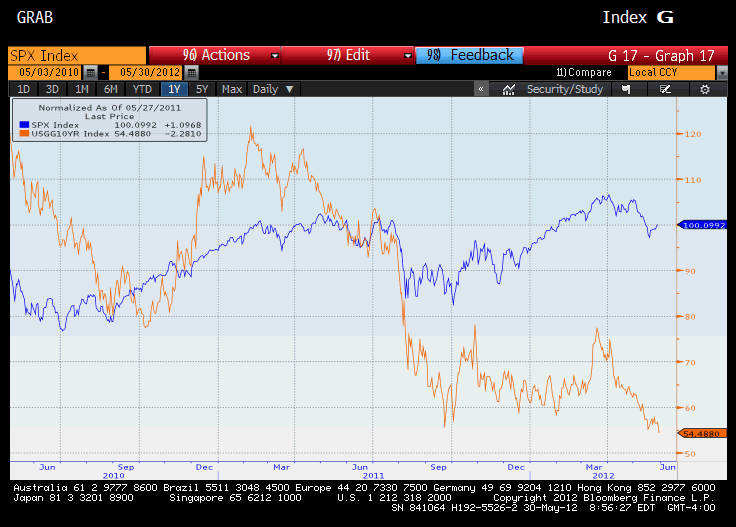This morning, the benchmark 10-year US treasury yield hit an all-time low of 1.65% and investors are clamoring to understand what this low of a yield means for their portfolio. What is more interesting is the increasing divergence of credit and equity markets in this respect. As shown by the chart below, prior to the debt ceiling debate last summer, the 10-year yield and the S&P 500 (on a normalized basis) largely tracked each other. Once the debt ceiling fiasco started, the 10-year yield nose-dived, as did stocks, but bond yields fell much further than did stocks. It appears as though the S&P 500 is extremely rich relative to the 10-year using this logic. However, the 10-year could also be artificially too low due to Operation Twist flattening the curve. Thus, there are a few ways to play this:

First, if investors believe that the divergence of the two benchmarks will reverse and the spread will narrow, a good trade idea would be to short the SPY ETF SPY and short the IEF IEF or TLH TLH ETF's (iShares 7-10 year and 10-20 year respectively). Thus, investors profit as long as the spread narrows, regardless of rates rising or falling.
Second, the 10-year yield and the USD/JPY rate also tend to track each other really well due to interest rate differentials and other similar characteristics, so an investor betting on the 10-year yield to go higher could long the USD/JPY or short the FXY ETF FXY. Conversely, if investors see a further deterioration of credit conditions in Europe (markets start to seize as they did last summer/fall), the 10-year yield would probably fall further, so one could short the dollar against the Yen.
Third, buy gold GLD on pull-backs, as a falling 10-year yield, and more importantly 10-year breakeven yield, signals disinflationary pressures in the near and medium terms. As disinflationary pressures mount, the Fed will be more likely to print. Thus, buying gold on pullbacks as a hedge to this potential of Fed action seems reasonable.
Last, BE TACTICAL. It is increasingly difficult to have a long-term or even medium-term view on the markets and the economy, as there are lots of unknowns and more importantly, the outcomes are largely controlled by politicians, which all but wipes out the probability of any swift and sweeping resolution. Investors who act more like traders and take advantage of large intraday swings may end up more profitable.
© 2025 Benzinga.com. Benzinga does not provide investment advice. All rights reserved.
Trade confidently with insights and alerts from analyst ratings, free reports and breaking news that affects the stocks you care about.